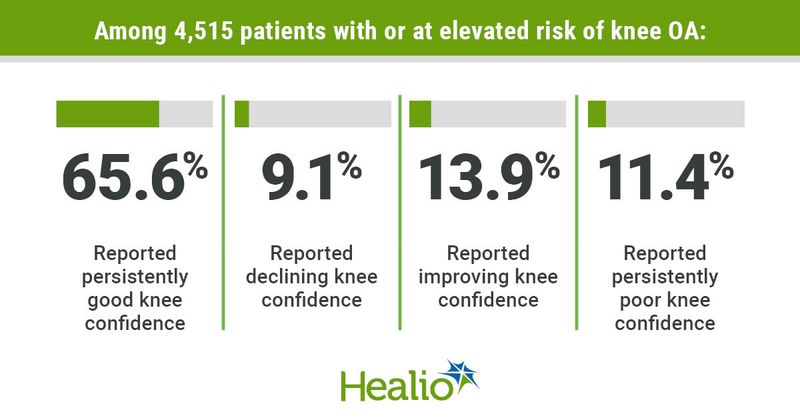Optimization of modifiable factors may prevent persistently poor knee confidence
By addressing modifiable factors, clinicians may prevent a long-term course of persistently poor knee confidence in patients with or at elevated risk for knee osteoarthritis, according to published results.
Alison H. Chang, PT, DPT, MS, and colleagues assessed knee confidence in 4,515 participants with or at elevated risk for knee OA by using the KOOS knee-related quality of life subscale to query how much individuals were troubled by lack of confidence in their knees (rated as not at all, mildly, moderately, severely or extremely troubled). Researchers collected patients’ self-reported knee confidence annually at baseline through the 96-month Osteoarthritis Initiative visit and defined lack of knee confidence as a score of two or greater. Researchers identified subgroups that shared similar underlying knee confidence trajectories during an 8-year period with latent class models and examined baseline factors associated with poor trajectories with multivariable, multinomial, logistic regression models.

Researchers identified four distinct knee confidence trajectories, with 65.6% of participants reporting persistently good confidence, 9.1% of participants reporting declining confidence, 13.9% of participants reporting improving confidence and 11.4% of participants reporting persistently poor confidence.
“Unlike knee pain, which remained largely unchanged over 6 years in previous reports, knee confidence was dynamic and may be an independent, significant feature when characterizing the long-term course of knee complaints,” Chang told Healio Orthopedics.
Results showed younger age, male sex, higher BMI, depressive symptoms, more advanced radiographic disease, worse knee pain, weaker knee extensors, history of knee injury and surgery, and reported hip and/or ankle pain were baseline predictors associated with persistently poor confidence. According to Chang, a multimodal biopsychosocial intervention, such as weight loss, strength and stability training, movement retraining, multi-site pain management and cognitive behavioral therapy, may improve the long-term course of knee confidence, as well as promote better function and activity participation in patients with or at elevated risk for knee OA.
“Our findings showed a strong dose-response association between radiographic disease severity and being in the unfavorable confidence trajectory (ie, the more severe the disease, the worse knee confidence trajectory),” Chang said. “Self-reported lack of knee confidence could serve as an additional multifaceted symptom marker for determining knee OA disease impact and tracking disease course. Clinicians may consider including inquiry about knee confidence, [such as] ‘How much are you troubled by lack of confidence in your knee(s)?’ in patient encounters.”

